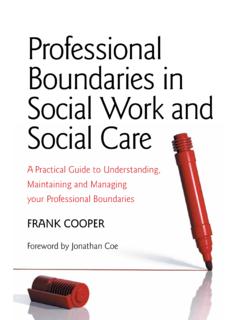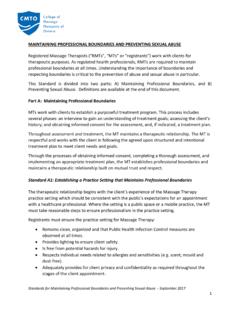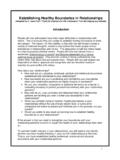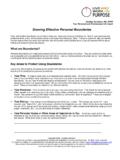Transcription of Professional Boundaries in a Therapeutic Relationship
1 Professional Boundaries in a Therapeutic Relationship2 College of Physical Therapists of BCJuly 1, 2009 The College of Physical Therapists of BC thanks the College of Physiotherapists of Ontario, the College of Physical Therapists of Alberta, and the College of Registered Nurses of BC for their permission to quote and adapt, in whole or in part, from their publications on Professional versus Professional s the Difference?3 You ve been treating a patient on and off for several years and have gotten to know each other quite well. Your Relationship is at the point that it feels more like you are reconnecting with an old friend. This is a good right? Or is it?In order to answer this question you need to know how a personal Relationship and a Professional Relationship differ from each other. Without knowing the differences between the Boundaries of a personal and Professional Relationship , how will you know if the line between the two is blurred or even crossed?
2 RelationshipsPersonal versus Professional s the Difference? differences between Professional & Personal Relationships5 Relationship CHARACTERISTICSPROFESSIONAL RELATIONSHIPPERSONAL RELATIONSHIPM oneyMoney is paid to the physical therapist for patient careSharedLengthLimited to the duration of physical therapyMay last a lifetimeLocationConfined to the treatment areaNo boundariesPurposeTo provide care to patientTo enjoy oneselfStructureDefined by the appointment length (and nature of care required)Spontaneous and unstructuredPower BalanceThe physical therapist is empowered by Professional skill and is privy to the patient s private informationSharedResponsibility for the RelationshipThe physical therapist establishes and maintains the Professional relationshipSharedPreparation for the relationshipThe physical therapist offers training and commitment and the patient places their trust in this Equal differences between Professional & Personal RelationshipsAdapted from: British Columbia Rehabilitation Society, understanding thetherapeutic relationshipRecognize that there is an element of risk in having both a Therapeutic Relationship and a personal Relationship with a patient simultaneously.
3 Take care to clarify roles with your relationships place the patient s needs first and foremost, and are at the core of physical therapy practice. Components of a Therapeutic Relationship that a physical therapist must consider when managing the Boundaries of the Relationship are: power, trust, respect, and closeness. It is extremely difficult to maintain a Therapeutic Relationship if any of these are There is an inherent power imbalance, in favour of the physical therapist, because the physical therapist has a disproportionate amount of knowledge compared to the patient, and the patient relies upon the physical therapist for assume that the physical therapist has the knowledge, skills, and abilities to provide quality care. resPecTPhysical therapists have a responsibility to respect a patient regardless of race, religion, ethnic origin, age, gender, sexual orientation, social or health Personal closenessThe context of a Therapeutic Relationship can include: physical closeness, varying degrees of undress, and disclosure of sensitive personal or emotional information which can lead to a patient feeling vulnerable.
4 7 understanding thetherapeutic Do You Define Professional Boundaries ?boundaryviolationsSome behaviours are never acceptable in a Therapeutic Relationship . Boundary violation is a deliberate behaviour by a physical therapist that is recognizably inappropriate and in violation of the nature of a Therapeutic Therapeutic relationships that lead to abuse, sexual relations, or romantic encounters are never appropriate and are prohibited. Verbal and non verbal behaviours that are never appropriate include: sarcasm, retaliation, intimidation, teasing or taunting, swearing, cultural slurs, and inappropriate tones of voice that express impatience or Do You Define Professional Boundaries ?There are grey areas around Professional Boundaries that require the use of good judgment and careful consideration of the context ( when, if ever, is it appropriate to hug a client?). While each separate situation may appear harmless, when put together they may form a pattern indicating that a boundary has been It can be difficult to put your finger on exactly why you feel uneasy when a certain patient comes in for treatment.
5 Ask yourself if a boundary was crossed either by you or your patient? To sum up: boundary crossing may begin with seemingly innocent comments or disclosures and escalate from blurringProfessional Boundaries are intended to set limits and clearly define a safe, Therapeutic connection between physical therapists and their Individual physical therapists must use clinical judgment to determine Therapeutic Boundaries . This can be difficult given that Boundaries differ from person to person, from one situation to the next, and tend to change over A boundary is a dynamic line which, if crossed, will constitute unprofessional behaviour and misuse of the stage for a Therapeutic Relationship : drawing the lineAs a physical therapist there are things you can do to set the stage for a Professional Relationship with clear Boundaries . These include: Introduction to the patient, by name and Professional title and description of role in the patient s care.
6 Addressing the patient by their preferred name or title. Active listening in a non-judgmental way. Using a patient centred approach in establishing treatment goals. Being aware of comments, attitudes, or behaviours that are inappropriate in a Therapeutic Relationship , and may cause discomfort. Obtaining informed consent to treatment (Health Care Consent and Facilities Admissions Act). Adhering to privacy regulation (Personal Information Protection Act and Freedom of Information and Protection of Privacy Act). Reflecting on your own patient behaviours are considered to be yellow lights because they may blur the Professional Boundaries that are in place to protect the patient. Below are some examples of yellow lights : Time spent with a patient beyond what is needed to meet the Therapeutic needs; Choosing patients based on factors such as looks, age, or social standing; Responding to personal overtures by the patient; Sharing personal problems with a patient; Dressing differently when seeing a particular patient; Frequently thinking about a patient outside of the context of the Therapeutic Relationship ; Being defensive or making excuses when someone comments on or questions your interactions with a patient; Being hesitant (except for reasons of confidentiality) or embarrassed to discuss the Relationship between you and your patient; Providing the patient with a home phone number or email address unless it is required in the context of a Therapeutic Relationship .
7 And Maintaining a patient on treatment longer than is lighTs: warning signs for boundary crossings5 Would I tell a colleague about this activity or behaviour? Would another physical therapist find my behaviour acceptable? Would I disclose my actions to a third party payer? Could my actions with the patient be misunderstood? Will these actions change the patient s expectations for care? Will these actions bias my clinical decision making? How would I feel explaining my actions to the College Inquiry Committee?12 think a boundary may have been crossed? ask yourselfIt is a physical therapist s duty to establish, maintain and monitor the Boundaries of a Therapeutic Relationship , and to take action if a boundary has been crossed. If so, roles need to be re-clarified by the physical therapist, and treatment goals re-established. If the Therapeutic Relationship can not be re-established it is the duty of the physical therapist to ensure that the patient is not adversely affected by any interruption in physical therapy care.
8 Be sure to document any boundary blurring or violation that occurs, including the action taken to re-establish the Professional Boundaries of the Therapeutic boundary has been crossed, now what?We generally only become aware of Boundaries once they have been practice as a standard precautionExamples of sensitive practice, as described in the Handbook, include: Using language that is clear to the patient when you obtain informed consent. Letting patients know they can have someone with them during assessment and treatment. Letting the patient know what the subjective and objective assessment involves before you proceed. Providing an opportunity for patients to ask questions. Completing the history before asking a patient to remove any clothing for the physical examination. Ensuring privacy for undressing and changing. Providing as private a treatment room as possible.
9 Re-visiting consent as the assessment or treatment to the Health Canada Handbook on Sensitive Practice for Health Care Practitioners8, as many as one third of women and 14% of men have experienced sexual abuse during childhood. These numbers suggest that sensitive practice should be viewed as a standard precaution, used for all patient practice as a standard precautionset the stage with appropriate Boundaries from the initial assessment. Patients take their cues for acceptable behaviour based on how you speak and harmless comments from the physical therapist or the patient can slide quickly into uncomfortable territory. correct these yellow light infractions is the physical therapist s responsibility tore-establish the Professional Boundaries , regardless of who crossed the both inappropriate behaviour and measures taken to re-establish the Professional clear Professional Boundaries to protect you and your patient.
10 Keypointsto rememberreferencesBritish Columbia Rehabilitation Society. Boundaries 1. Workshop Materials. of Chiropractors of Ontario, College of Massage 2. Therapists of Ontario, College of Physical Therapists of Ontario. Where s my line? Toronto, Ontario. College of Physical Therapists of Alberta. Therapeutic 3. relationships: Establishing and maintaining Professional Boundaries . [Online]. 2007 [cited 2008 Nov 18]; Available from: of Physical Therapists of BC. Bylaw 55 (Code of 4. Ethics). Vancouver, British Columbia, of Physiotherapists of Ontario. Guide to the standard 5. for establishing and maintaining Therapeutic relationships. [Online]. 2005 [cited 2008 Nov 18]; Available from: URL: College of Registered Nurses of British Columbia. Practice 6. support. Nurse-client relationships. [Online]. 2006 [cited 2008 Nov 18]; Available from: of Registered Nurses of Nova Scotia. Professional 7.








